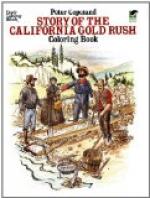The Mission and Presidio of San Francisco were founded in 1776 by Father Palou, and two little settlements grew up around the fort and at the church. The Presidio was built where it is now, and ships used to anchor in the bay in front of it, though the whalers usually went to Sausalito to get wood from the hills and to fill their water-casks at a large spring. From early Mission times the Spanish name of Yerba Buena was given to that part of San Francisco’s peninsula between Black Point and Rincon Point. Ship-captains and sailors soon found out that the cove or bay east of Yerba Buena was the best and least windy place to anchor their vessels, and later on hundreds of ships found a safe harbor there. The name Yerba Buena, or good herb, was given on account of a little creeping vine with sweet-smelling leaves which covered the ground and is still found on the sand-dunes and Presidio hills.
For many years the small settlements made no progress, and the rest of the peninsula was covered with thick woods, where the grizzly bear, wolf, and coyote roamed, while deer were plenty at the Presidio. Then in 1835 Governor Figueroa, the Mexican ruler of California, directed that a new town should be started at Yerba Buena cove. The first street, called the “foundation-street,” was laid out from Pine and Kearny streets, as they are called to-day, to North Beach. The first house was built by Captain Richardson on what is now Dupont Street, between Clay and Washington. The next year a trader named Jacob Leese built a store. It was finished on the Fourth of July, and in honor of the day he gave a feast and a fandango, or dance, at which the company danced that night and all the next day. This was the first Fourth celebrated in the place.
Two or three years later a new survey laid out streets between Broadway and California, Montgomery and Powell. A fresh-water lagoon, or lake, was near the present corner of Montgomery and Sacramento, and an Indian temescal, or sweat-house, beside it. The bay came up to Montgomery Street then, with five feet of water at Sansome, and mudflats to the east. During the gold excitement of ’49, when hundreds of ships dropped anchor in the bay, many sailors deserted to go to the mines, and some of the old vessels were hauled in on these mud-flats and made into storehouses. All that part of the city east of Montgomery Street is filled or made ground, and when new buildings are to be started wooden piles or cement piers must go down to get a firm foundation.
Until 1846 only about thirty families lived at Yerba Buena. Then a shipload of Mormon emigrants arrived and pitched their tents in the sand-hills. Samuel Brannan, their leader, printed the first newspaper, The California Star, in ’47. That year also the first alcalde, or mayor, of the new town, Lieutenant Bartlett, appointed an engineer named O’Farrell to lay out more streets. He surveyed Market Street and mapped down blocks as far west on the sand-dunes as Taylor Street and to Rincon Point or South Beach. He gave the names of such well-known men as Kearny, Stockton, Larkin, Guerrero, and Geary to these streets. Mission Street was the road to the Mission Dolores, and about this time Bartlett ordered that the Presidio, the Mission, and Yerba Buena should be one town and should be called San Francisco.




